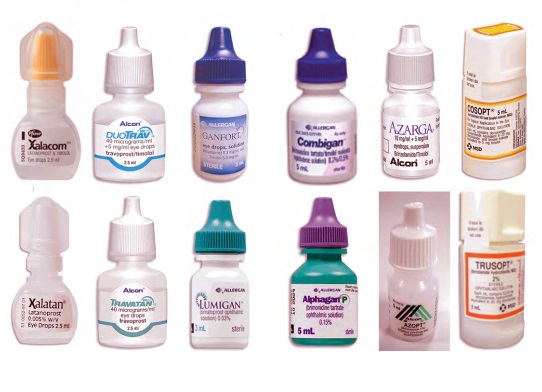Canadian Study Finds That Most Present Drugs Used for Glaucoma Treatments Can Cause Adverse Issues!
Nikhil Prasad Fact checked by:Thailand Medical News Team Jan 13, 2025 3 months, 58 minutes ago
Medical News: Glaucoma is one of the most prevalent causes of irreversible blindness worldwide, affecting millions of individuals and posing significant public health challenges. This silent yet progressive condition, marked by optic nerve damage, frequently goes undiagnosed until advanced stages, leading to substantial vision loss. The primary treatment strategy for glaucoma centers on lowering intraocular pressure (IOP), which is achieved through various pharmacological agents. However, these treatments are not without risks. Recent research highlights the potential ocular and systemic complications associated with glaucoma medications, underscoring the need for careful management and patient-specific approaches.
 Canadian Study Finds That Most Present Drugs Used for Glaucoma Treatments Can Cause Adverse Issues
Canadian Study Finds That Most Present Drugs Used for Glaucoma Treatments Can Cause Adverse Issues
The study discussed in this
Medical News report was conducted by researchers from the Temerty Faculty of Medicine, the Department of Ophthalmology and Vision Sciences at the University of Toronto, and the Donald K. Johnson Eye Institute, affiliated with the Krembil Research Institute at the University Health Network in Toronto, Canada.
Mechanisms of Glaucoma Treatments
Glaucoma medications are categorized based on their mechanisms of action: some reduce the production of aqueous humor in the eye, while others enhance its outflow. Among the widely used classes are carbonic anhydrase inhibitors, beta-blockers, alpha-adrenergic agonists, prostaglandin analogues, parasympathomimetics, rho kinase inhibitors, and hyperosmotic agents. Each class offers unique benefits but also carries potential adverse effects, ranging from mild irritation to serious systemic impacts.
This article delves into the findings of a comprehensive review of ocular and systemic side effects associated with these medications, offering insights into their mechanisms and implications for patient care. By understanding these risks, clinicians can better tailor treatments to minimize side effects and enhance adherence.
Key Findings from the Review
-Carbonic Anhydrase Inhibitors (CAIs)
CAIs function by inhibiting an enzyme crucial for aqueous humor production. Available in both oral and topical formulations, CAIs are effective but not without side effects. Oral agents like acetazolamide can significantly reduce IOP but are linked to serious systemic effects, including general malaise, weight loss, fatigue, and even metabolic acidosis. In contrast, topical formulations such as dorzolamide and brinzolamide offer a more favorable safety profile, though ocular side effects like stinging, redness, and blurred vision are common.
-Beta-Blockers
Beta-blockers, including timolol and betaxolol, are well-established in glaucoma management. They reduce IOP by decreasing aqueous humor production. While effective, these medications can cause systemic issues such as bradycardia, respiratory distress, and depression, especially in patients with pre-existing conditions. Ocular side effects, including burning sensations
and dryness, are also reported.
-Alpha-Adrenergic Agonists
This class, represented by drugs like brimonidine and apraclonidine, offers dual benefits of reducing aqueous humor production and enhancing outflow. However, they are associated with a high incidence of allergic reactions, fatigue, and dry mouth. Brimonidine is particularly noted for causing ocular allergies in up to 26% of patients, requiring careful monitoring.
-Prostaglandin Analogues (PGAs)
PGAs are often first-line treatments due to their efficacy and once-daily dosing convenience. These drugs, including latanoprost and bimatoprost, enhance outflow through the uveoscleral pathway. While they are generally well-tolerated, side effects such as iris pigmentation changes, eyelash growth, and conjunctival hyperemia are common. Rare but serious complications include anterior uveitis and cystoid macular edema.
-Parasympathomimetics
Once a mainstay in glaucoma therapy, parasympathomimetics like pilocarpine are now less commonly used due to their side effects. These include pupil constriction, ciliary muscle spasms, and potential for retinal detachment. Despite these drawbacks, they remain valuable in certain acute scenarios, such as angle-closure glaucoma.
-Rho Kinase Inhibitors and Hyperosmotic Agents
Newer to the therapeutic landscape, rho kinase inhibitors like netarsudil offer modest IOP reduction with side effects such as conjunctival hyperemia and corneal verticillata. Hyperosmotic agents, such as mannitol, are used in acute situations but can lead to systemic complications, including dehydration and electrolyte imbalances.
Implications for Patient Care
The side effects of glaucoma medications can significantly impact patient adherence and quality of life. For instance, ocular irritation or allergic reactions may lead patients to discontinue treatment, while systemic complications can pose serious health risks. Addressing these challenges requires a multifaceted approach:
-Personalized Treatment Plans: Tailoring medication choices based on individual patient profiles, including their medical history and lifestyle, can help mitigate risks.
-Patient Education: Informing patients about potential side effects and the importance of adherence can improve outcomes. Patients should be encouraged to report any adverse effects promptly.
-Monitoring and Follow-Up: Regular follow-up appointments allow clinicians to assess the effectiveness of treatment and make necessary adjustments.
-Exploring Alternatives: Emerging therapies, such as sustained-release formulations and minimally invasive surgical options, may offer solutions with fewer side effects.
Conclusion
The review underscores the need for ongoing research and innovation in glaucoma treatment. While current medications are effective in lowering IOP, their associated risks highlight the importance of personalized care and vigilant monitoring. By integrating patient-reported outcomes into clinical practice and exploring novel therapeutic strategies, clinicians can enhance the management of this complex condition. The findings emphasize that a one-size-fits-all approach is inadequate; instead, a patient-centered strategy is key to improving adherence and preserving vision.
The study findings were published on a preprint server and are currently being peer reviewed.
https://www.preprints.org/manuscript/202411.0234/v1
For the latest Glaucoma News, keep on logging to Thailand
Medical News.
Read Also:
https://www.thailandmedical.news/news/sodium-levels-linked-to-glaucoma-risk
https://www.thailandmedical.news/news/blood-pressure-fluctuations-may-worsen-glaucoma-progression
https://www.thailandmedical.news/articles/glaucoma-news
